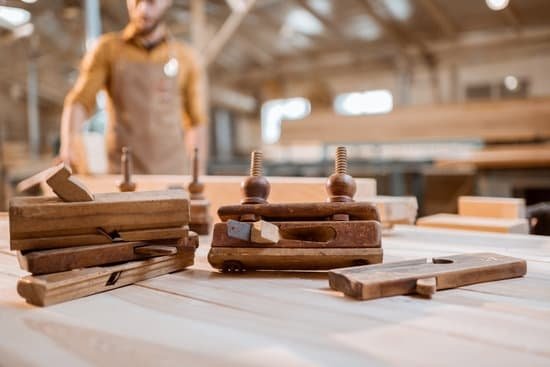Bench vises are an essential tool in any woodworking workshop, providing a reliable and secure way to hold workpieces in place while they are being cut, drilled, or shaped. Whether you’re a professional woodworker or a hobbyist, having the right bench vise can make a significant difference in the quality and efficiency of your projects. In this article, we will explore the necessity of bench vises in woodworking and delve into the various aspects of their importance.
One of the essential components of any woodworking bench setup is a reliable bench vise. It serves as an extra set of hands, allowing woodworkers to secure workpieces firmly in place and work on them without worrying about slippage or movement. From holding large panels for planing to securing intricate joinery for precise cutting, bench vises play a crucial role in ensuring accuracy and safety in woodworking tasks.
In this comprehensive guide, we will discuss the different types of bench vises available, their unique uses in woodworking applications, the benefits they offer to woodworkers, specific projects that heavily rely on bench vises, tips for selecting the right bench vise for your needs, alternative clamping methods for woodworking projects, and practical advice on how to use bench vises effectively.
Whether you are new to woodworking or looking to upgrade your workshop equipment, understanding the importance of bench vises is essential for anyone passionate about working with wood.
Types of Bench Vises
Woodworking Bench Vises
Woodworking bench vises are essential tools for any woodworking shop. They come in various types, each designed for specific uses and applications. Understanding the different types of bench vises available can help woodworkers choose the right one for their projects.
Types of Bench Vises
There are several types of bench vises commonly used in woodworking, including the front vise, end vise, tail vise, and shoulder vise. Front vises are typically mounted on the front edge of a workbench and are used for holding boards or other workpieces flat on the bench. End vises, on the other hand, can be mounted on the end of a workbench and are often used for holding long pieces of wood that extend beyond the edge of the bench.
Tail vises are usually mounted at the end of a workbench and have a sliding jaw to hold workpieces securely. Shoulder vises are designed to hold large panels or doors upright while working on their edges.
Uses in Woodworking
Each type of bench vise has its own unique uses in woodworking. For example, front vises are ideal for securing boards while planing or chiseling, while end vises are perfect for holding long pieces for tasks such as sawing or drilling.
Tail vises can be useful for holding smaller workpieces securely during detailed tasks, and shoulder vises excel at providing support when working with larger panels or doors. Understanding how each type of bench vise is best utilized can greatly enhance woodworking efficiency and precision.
Overall, having a variety of bench vises available in a woodworking shop can greatly improve the quality and accuracy of projects. Considering the different types and their individual uses is crucial when equipping a workshop for woodworking tasks that require secure clamping and holding mechanisms.
Benefits of Using Bench Vises
Bench vises are essential tools in any woodworking workshop, offering a wide range of benefits that make them a valuable investment for both amateur and professional woodworkers. Here are some of the key advantages of using bench vises:
- Stability and secure clamping: One of the primary benefits of bench vises is their ability to securely hold workpieces in place. This stability is crucial when performing intricate woodworking tasks such as carving, sanding, or shaping, as it ensures that the material remains steady and safe throughout the process.
- Versatility: Bench vises come in various designs, including woodworking bench vises, machinist’s vises, and engineer’s vises. Each type offers specific features that cater to different woodworking needs. For example, woodworking bench vises usually have wider jaws and higher clamping forces to accommodate larger workpieces, while engineer’s vises may have swivel bases for enhanced maneuverability.
- Precision and control: With a bench vise, woodworkers can achieve greater precision and control over their work. The ability to firmly grip materials allows for accurate cutting, drilling, and joinery without the risk of slippage or movement. This level of control ultimately contributes to the overall quality of woodworking projects.
In addition to the benefits mentioned above, bench vises also contribute to improved safety by reducing the likelihood of accidents caused by loose or unstable workpieces. They provide a solid foundation for executing intricate tasks with ease and confidence.
Furthermore, bench vises enhance efficiency in woodworking workshops by streamlining processes and minimizing time spent on securing materials. Whether it’s holding pieces for assembly or keeping stock in place for planing or sanding, having reliable bench vises can significantly increase productivity and workflow.
Overall, it’s clear that bench vises play a crucial role in woodworking by providing stability, versatility, precision, control, safety, and efficiency – making them an essential addition to any woodworker’s toolkit.
Projects That Require Bench Vises
Woodworking projects often require precise and secure clamping in order to effectively work with wood. Bench vises are essential tools that provide stability and support during a variety of woodworking tasks. Here are some specific projects that heavily rely on bench vises for successful completion:
- Wood Joinery: When it comes to creating strong and seamless joints, bench vises play a crucial role in holding pieces of wood together as the glue dries or when using tools such as chisels and saws.
- Carving and Shaping: Whether it’s carving intricate designs or shaping wood into specific forms, bench vises offer the necessary grip and support to safely manipulate the material without it slipping or moving unexpectedly.
- Assembly Work: Assembling wooden components into larger structures like furniture or cabinets requires stability, alignment, and pressure which can be achieved through the use of bench vises.
These are just a few examples of woodworking projects that greatly benefit from the use of bench vises. Without them, achieving precision and quality in these tasks would be significantly more challenging.
Furthermore, utilizing the right type of bench vise for each project is important. For instance, woodworking vises typically have wooden jaws to prevent marring soft woods while metalworking vises have hardened steel jaws for withstanding heavy force. When selecting a bench vise, it’s crucial to consider the specific needs of the project at hand.
How to Choose the Right Bench Vise
When it comes to woodworking, having the right tools is essential for achieving professional and high-quality results. One of the most important tools in a woodworker’s arsenal is the bench vise. It serves as a reliable clamping device that securely holds workpieces in place, allowing for precision and stability during cutting, drilling, sanding, and other woodworking tasks.
Consider the Size and Type
When selecting a bench vise for woodworking, it’s important to consider the size and type that will best suit your needs. Bench vises come in various sizes and styles, including traditional front vises, end vises, and combination vises.
Front vises are commonly used for holding workpieces along the front edge of a workbench, while end vises are ideal for securing longer pieces from the end of a workbench. Combination vises offer versatility by providing both front and end vise capabilities.
Look for Durability and Stability
Durability is crucial when choosing a bench vise for woodworking. Look for a vise made from sturdy materials such as cast iron or steel, as these materials can withstand heavy-duty use and provide long-lasting performance. Additionally, stability is key to ensure that the bench vise can securely hold workpieces without wobbling or shifting during woodworking tasks.
Consider Additional Features
Some bench vises come with additional features that can enhance their functionality. For example, quick-release mechanisms allow for rapid adjustment of the vise opening, while swivel bases enable rotation of the vise to different angles for better access to workpieces. Consider these extra features based on your specific woodworking needs to make your projects more efficient and productive.
By carefully considering the size, type, durability, stability, and additional features of bench vises available on the market today, woodworkers can make informed decisions when selecting the best bench vise for their woodworking workshops. With the right bench vise in place, woodworkers can achieve greater precision and control in their projects while ensuring safety and efficiency in their workshop environment.
Alternatives to Bench Vises
When it comes to woodworking, bench vises are often considered an essential tool for securing workpieces in place and providing a stable surface for various tasks. However, there may be situations where a bench vise is not available or suitable for the task at hand. In such cases, woodworkers can turn to alternative clamping methods to achieve the same level of stability and precision.
One popular alternative to bench vises is the use of C-clamps or G-clamps. These types of clamps are versatile and can be easily adjusted to secure workpieces to a workbench or other surfaces. They come in various sizes and are capable of holding different shapes and sizes of materials firmly in place. C-clamps and G-clamps are especially useful when working with irregularly shaped objects or when additional clearance is needed.
Another common alternative to bench vises is the use of toggle clamps. These clamps are designed to quickly and securely hold down workpieces, making them ideal for repetitive tasks that require consistent pressure and positioning. Toggle clamps come in horizontal, vertical, push-pull, and latch action styles, offering woodworkers a wide range of options for different applications.
In addition to traditional clamping methods, woodworkers can also utilize quick-release bar clamps, pipe clamps, hand screw clamps, and band clamps as substitutes for bench vises. Each type of clamp has its own strengths and limitations, so it’s important to consider the specific requirements of the woodworking project at hand when choosing an alternative clamping method.
| Alternative Clamping Method | Advantages |
|---|---|
| C-Clamp/G-Clamp | Versatile, easily adjustable |
| Toggle Clamp | Quick and secure hold on workpieces |
| Quick-Release Bar Clamp | Rapid application and release of pressure |
Tips for Using Bench Vises Effectively
Bench vises are a crucial tool in any woodworking workshop, providing a secure and stable way to hold workpieces in place while working on them. However, simply having a bench vise is not enough – knowing how to use it effectively is equally important. Here are some practical tips for getting the most out of your bench vise in woodworking projects.
First and foremost, it’s essential to position the bench vise correctly. Mounting it at the right height and location on your workbench will make a significant difference in its usability. The vise should be installed so that the jaws are at a comfortable working height for you, and positioned closer to the edge of the workbench for optimal support and stability.
When using a bench vise, it’s crucial to clamp the workpiece securely without over-tightening. Applying excessive pressure can damage both the workpiece and the vise itself. It’s important to find the right balance – tight enough to hold the piece firmly in place, but not so tight that it causes damage. Additionally, placing wood scraps or protective pads between metal surfaces and the vise jaws can help prevent marring or indentations on the workpiece.
Another tip for using bench vises effectively is to utilize additional accessories such as soft jaws or clamping blocks. These accessories can provide extra cushioning and support when working with delicate or irregularly shaped pieces, ensuring that they remain stable during cutting, sanding, or drilling processes. It’s also important to regularly maintain your bench vise by cleaning off sawdust and debris from its moving parts, lubricating it as necessary, and checking for any signs of wear or damage.
By following these practical tips for using bench vises effectively, woodworkers can ensure better precision, safety, and convenience when working on various projects. Remember that mastering the use of a bench vise takes practice – but with time and experience, you’ll be able to maximize its potential in your woodworking endeavors.
Conclusion
In conclusion, bench vises are indeed a necessary tool in woodworking. From providing stability and support to allowing for precise and secure clamping of workpieces, bench vises play a crucial role in various woodworking tasks. With their ability to hold pieces firmly in place while cutting, shaping, or sanding, they contribute to the safety and accuracy of the overall woodworking process.
Throughout this article, we have explored the different types of bench vises available and their specific uses in woodworking. We have also delved into the numerous benefits of incorporating bench vises into a woodworking workshop, as well as highlighted specific projects that heavily rely on their use. Additionally, practical tips for selecting the right bench vise and using it effectively have been shared.
Ultimately, whether you are a professional woodworker or an enthusiast tackling DIY projects at home, having a reliable bench vise can significantly enhance the quality and precision of your work. It is important to understand the specific needs of your woodworking projects and choose a bench vise that best addresses those requirements. In summary, the significance of bench vises in woodworking cannot be overstated, and they are indispensable tools for anyone serious about pursuing this craft.
Frequently Asked Questions
Do You Need a Woodworking Vice?
A woodworking vice is an essential tool for anyone working with wood, as it helps secure the workpiece in place while cutting, drilling, or shaping. It provides stability and allows for more precise and controlled work.
What Is the Need of Bench Vice in Carpentry?
A bench vice is crucial in carpentry because it holds the workpiece securely in place, allowing the carpenter to focus on the task at hand without worrying about the piece moving or shifting. This stability is essential for accuracy and safety.
What Is a Woodworking Bench Vise Used For?
A woodworking bench vise is used to firmly clamp down on a piece of wood, metal, or other materials to hold them steady during cutting, sawing, planning, gluing, or sanding tasks. It provides stability and control, ultimately leading to better results in woodworking projects.

Hi everyone! I’m a woodworker and blogger, and this is my woodworking blog. In my blog, I share tips and tricks for woodworkers of all skill levels, as well as project ideas that you can try yourself.





